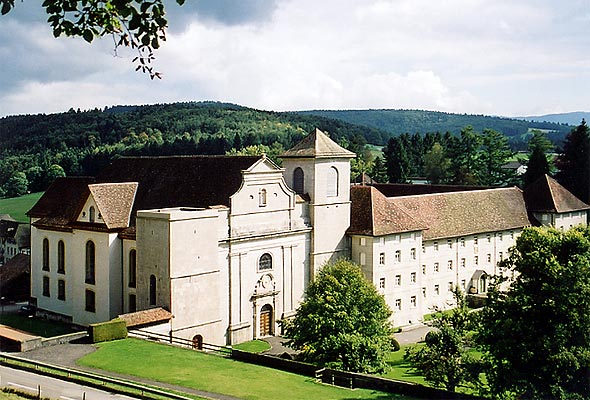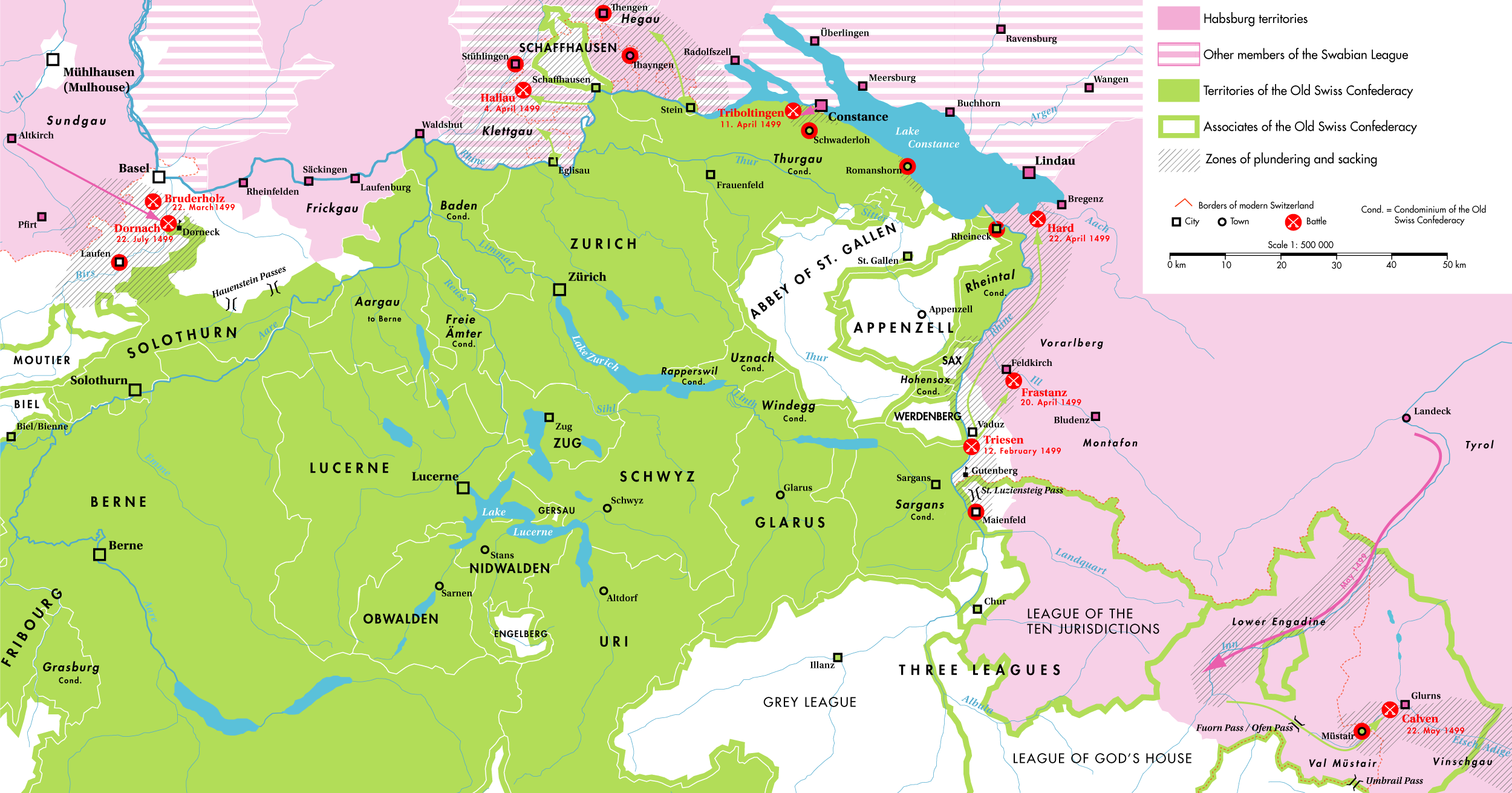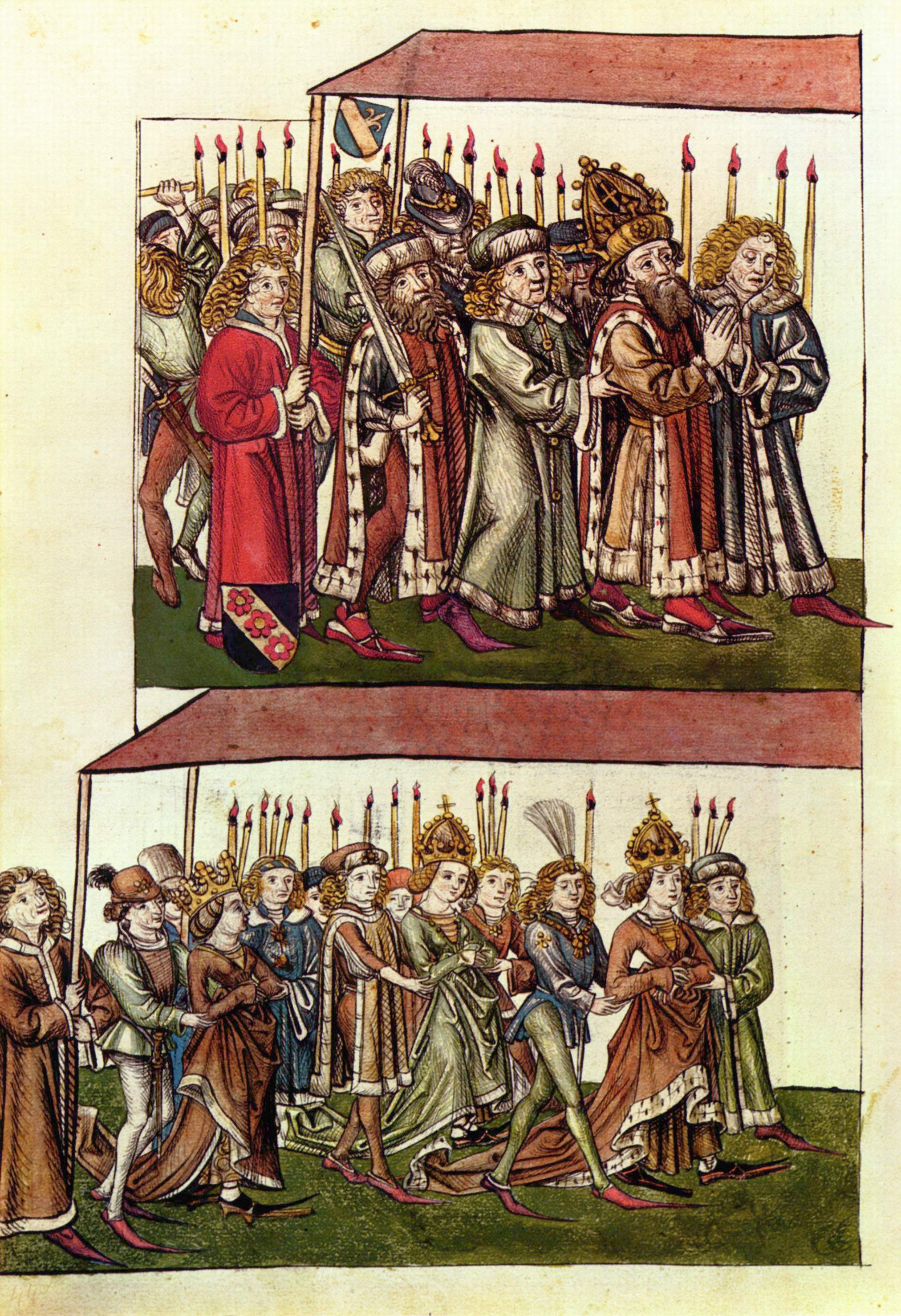|
Bellelay Abbey
Bellelay Abbey is a former Premonstratensian monastery in the Bernese Jura in Switzerland, now a psychiatric clinic. It is a heritage site of national significance and the entire former Abbey complex is part of the Inventory of Swiss Heritage Sites. History According to the legend, the monastery was founded in 1136 by Siginand, prior of the abbey of Moutier-Grandval, who got lost in the deep forest of the High Jura while hunting a wild boar and was unable to find his way out. He vowed to found a monastery if he managed to return safely to Moutier, which he did four days later. To the monastery he founded in accordance with his vow he gave the name of "belle laie" ("laie" is a female wild boar). According to other sources, the monastery was probably founded as a result of the influence of the Bishop of Basel on the south-west border of the diocese of Basel with the territory of the Abbot of Moutier-Grandval. The foundation was confirmed by Pope Innocent II in 1142. [...More Info...] [...Related Items...] OR: [Wikipedia] [Google] [Baidu] |
Grenzach-Wyhlen
Grenzach-Wyhlen is a municipality of 15,000 people in the district of Lörrach in Baden-Württemberg, Germany. It sits on the right bank of the Rhine abutting the Swiss municipalities of Riehen and Bettingen in the Kanton of Basel-Stadt, the German municipality of Inzlingen and the German town of Rheinfelden. Its town hall is 6.5 km east of that of Basel and 8 km south of that of Lörrach. History Grenzach-Wyhlen was established on January 1, 1975 from the two independent municipalities Grenzach and Wyhlen in the course of the Baden-Württemberg reform of the local governments. First settlements in today's municipality area are of Celtic origin, belonging to the Hallstatt culture in the early 1st millennium BC. The Celtic settlement was followed by Roman settlements and from the 3rd century on by Alemannic ones. The name "Wyhlen" originates in Alemannic "ze wilon", meaning "at the farmstead". The Roman settlement was called Carantiacum (well of Carantius). ... [...More Info...] [...Related Items...] OR: [Wikipedia] [Google] [Baidu] |
Canton Of Bern
The canton of Bern, or Berne (; ; ; ), is one of the Canton of Switzerland, 26 cantons forming the Switzerland, Swiss Confederation. Its capital city, Bern, is also the ''de facto'' capital of Switzerland. The bear is the heraldic symbol of the canton, displayed on a red-yellow background. Comprising Subdivisions of the canton of Bern, ten districts, Bern is the second-largest canton by both surface area and population. Located in west-central Switzerland, it is surrounded by eleven cantons. It borders the cantons of canton of Jura, Jura and canton of Solothurn, Solothurn to the north. To the west lie the cantons of canton of Neuchâtel, Neuchâtel, canton of Fribourg, Fribourg, and canton of Vaud, Vaud. To the south lies the cantons of canton of Valais, Valais. East of the canton of Bern lie the cantons of Canton of Uri, Uri, Canton of Nidwalden, Nidwalden, Canton of Obwalden, Obwalden, Canton of Lucerne, Lucerne and Canton of Aargau, Aargau. The geography of the canton includes ... [...More Info...] [...Related Items...] OR: [Wikipedia] [Google] [Baidu] |
Saignelégier
Saignelégier () is a Municipalities of Switzerland, municipality in the canton of Jura in Switzerland. It is the seat of the Franches-Montagnes (district), district of Franches-Montagnes. On 1 January 2009, the formerly independent municipalities of Goumois and Les Pommerats merged into Saignelégier. The bog and nature preserve around étang de la Gruère is located in the municipality. It is also the home of noted brewery Brasserie des Franches-Montagnes. History Saignelégier is first mentioned in 1294 as ''Saignelegier''. The municipality was formerly known by its German name ''Sankt Leodegar'', however, that name is no longer used. During the Middle Ages the village of Saignelégier was part of the Roman Catholic Diocese of Basel, diocese of Basel. During the 15th century, Saignelégier began to grow into an important regional town. A chapel was built and a yearly market started in 1428. Around the same time, the pastor of Montfaucon, Switzerland, Montfaucon, the h ... [...More Info...] [...Related Items...] OR: [Wikipedia] [Google] [Baidu] |
France
France, officially the French Republic, is a country located primarily in Western Europe. Overseas France, Its overseas regions and territories include French Guiana in South America, Saint Pierre and Miquelon in the Atlantic Ocean#North Atlantic, North Atlantic, the French West Indies, and List of islands of France, many islands in Oceania and the Indian Ocean, giving it Exclusive economic zone of France, one of the largest discontiguous exclusive economic zones in the world. Metropolitan France shares borders with Belgium and Luxembourg to the north; Germany to the northeast; Switzerland to the east; Italy and Monaco to the southeast; Andorra and Spain to the south; and a maritime border with the United Kingdom to the northwest. Its metropolitan area extends from the Rhine to the Atlantic Ocean and from the Mediterranean Sea to the English Channel and the North Sea. Its Regions of France, eighteen integral regions—five of which are overseas—span a combined area of and hav ... [...More Info...] [...Related Items...] OR: [Wikipedia] [Google] [Baidu] |
Thirty Years' War
The Thirty Years' War, fought primarily in Central Europe between 1618 and 1648, was one of the most destructive conflicts in History of Europe, European history. An estimated 4.5 to 8 million soldiers and civilians died from battle, famine, or disease, while parts of Germany reported population declines of over 50%. Related conflicts include the Eighty Years' War, the War of the Mantuan Succession, the Franco-Spanish War (1635–1659), Franco-Spanish War, the Torstenson War, the Dutch-Portuguese War, and the Portuguese Restoration War. The war had its origins in the 16th-century Reformation, which led to religious conflict within the Holy Roman Empire. The 1555 Peace of Augsburg attempted to resolve this by dividing the Empire into Catholic and Lutheran states, but the settlement was destabilised by the subsequent expansion of Protestantism beyond these boundaries. Combined with differences over the limits of imperial authority, religion was thus an important factor in star ... [...More Info...] [...Related Items...] OR: [Wikipedia] [Google] [Baidu] |
Protestant Reformation
The Reformation, also known as the Protestant Reformation or the European Reformation, was a time of major theological movement in Western Christianity in 16th-century Europe that posed a religious and political challenge to the papacy and the authority of the Catholic Church. Towards the end of the Renaissance, the Reformation marked the beginning of Protestantism. It is considered one of the events that signified the end of the Middle Ages and the beginning of the early modern period in Europe. The Reformation is usually dated from Martin Luther's publication of the '' Ninety-five Theses'' in 1517, which gave birth to Lutheranism. Prior to Martin Luther and other Protestant Reformers, there were earlier reform movements within Western Christianity. The end of the Reformation era is disputed among modern scholars. In general, the Reformers argued that justification was based on faith in Jesus alone and not both faith and good works, as in the Catholic view. In the ... [...More Info...] [...Related Items...] OR: [Wikipedia] [Google] [Baidu] |
Swabian War
The Swabian War of 1499 ( (spelling depending on dialect), called or ("Swiss War") in Germany and ("War of the Engadin" in Austria) was the last major armed conflict between the Old Swiss Confederacy and the House of Habsburg. What had begun as a local conflict over the control of the Val Müstair and the Umbrail Pass in the Grisons soon got out of hand when both parties called upon their allies for help; the Habsburgs demanding the support of the Swabian League, while the Federation of the Three Leagues of the Grisons turning to the Swiss '' Eidgenossenschaft''. Hostilities quickly spread from the Grisons through the Rhine valley to Lake Constance and even to the Sundgau in southern Alsace, the westernmost part of the Habsburg region of Further Austria.The main references used are Morard in general and Riezler for the detailed chronology in the section on the course of the war. Many battles were fought from January to July 1499, and in all but a few minor skirmishes, th ... [...More Info...] [...Related Items...] OR: [Wikipedia] [Google] [Baidu] |
Imperial Abbey
Princely abbeys (, ''Fürststift'') and Imperial abbeys (, ''Reichskloster'', ''Reichsstift'', ''Reichsgotthaus'') were religious establishments within the Holy Roman Empire which enjoyed the status of imperial immediacy (''Reichsunmittelbarkeit'') and therefore were answerable directly to the Emperor. The possession of imperial immediacy came with a unique form of territorial authority known as '' Landeshoheit'', which carried with it nearly all the attributes of sovereignty. Princely abbeys and imperial abbeys The distinction between a princely abbey and an imperial abbey was related to the status of the abbot: while both prince-abbots and the more numerous imperial abbots sat on the ecclesiastical bench of the College of ruling princes of the Imperial Diet, prince-abbots cast an individual vote while imperial abbots cast only a curial (collective) vote alongside his or her fellow imperial abbots and abbesses. Eight princely abbeys (including similar status priories) and ro ... [...More Info...] [...Related Items...] OR: [Wikipedia] [Google] [Baidu] |
Council Of Constance
The Council of Constance (; ) was an ecumenical council of the Catholic Church that was held from 1414 to 1418 in the Bishopric of Constance (Konstanz) in present-day Germany. This was the first time that an ecumenical council was convened in the Holy Roman Empire. The council ended the Western Schism by deposing or accepting the resignation of the remaining papal claimants and by electing Pope Martin V. It was the last papal election to take place outside of Italy. The council also condemned Jan Hus as a heretic and facilitated his execution; and it ruled on issues of national sovereignty and the rights of pagans and just war in response to a conflict between the Grand Duchy of Lithuania, the Kingdom of Poland and the Order of the Teutonic Knights. The council is also important for its role in the debates over ecclesial conciliarism and papal supremacy. Constance issued two particularly significant decrees regarding the constitution of the Catholic Church: '' Haec sancta'' ... [...More Info...] [...Related Items...] OR: [Wikipedia] [Google] [Baidu] |
High, Middle And Low Justice
High, middle and low justices are notions dating from Western feudalism to indicate descending degrees of judicial power to administer justice by the maximal punishment the holders could inflict upon their subjects and other dependents. The scale of punishment generally matched the scale of spectacle (e.g. a public hanging = high justice), so that in France, Paul Friedland argues: "The degree of spectacle [was] originally the basis for a distinction between high and low justice", with an intervening level of 'middle justice', characterised by limited or modest spectatorship, added around the end of the fourteenth century. Low justice regards the level of day-to-day Civil law (common law), civil actions, including voluntary justice, minor pleas, and Misdemeanor, petty offences generally settled by Fine (penalty), fines or light corporal punishment. It was held by many lesser authorities, including many Lord of the manor, lords of the manor, who sat in justice over the serfs, unfree ... [...More Info...] [...Related Items...] OR: [Wikipedia] [Google] [Baidu] |
Biel/Bienne
Biel/Bienne (official bilingual wording; German language, German: ''Biel'' ; French language, French: ''Bienne'' ; Bernese German, locally ; ; ; ) is a bilingual city in the canton of Bern in Switzerland. With over 55,000 residents, it is the country's List of cities in Switzerland, tenth-largest city by population. The Biel urban area has a population of around 100,000 inhabitants. Biel/Bienne is the capital of the Biel/Bienne (administrative district), Biel/Bienne administrative district. The city has been an industrial and watchmaking heart of Switzerland since the 19th century. With world-famous watch brands such as Rolex, Omega SA, Omega and Swatch based in Biel/Bienne, the city is one of the main centres of the Swiss watch industry and is also referred to as the "world capital of watchmaking". Biel/Bienne lies on the language boundary between the French language, French-speaking and German language, German-speaking parts of Switzerland, and is bilingual throughout. ''Biel ... [...More Info...] [...Related Items...] OR: [Wikipedia] [Google] [Baidu] |








